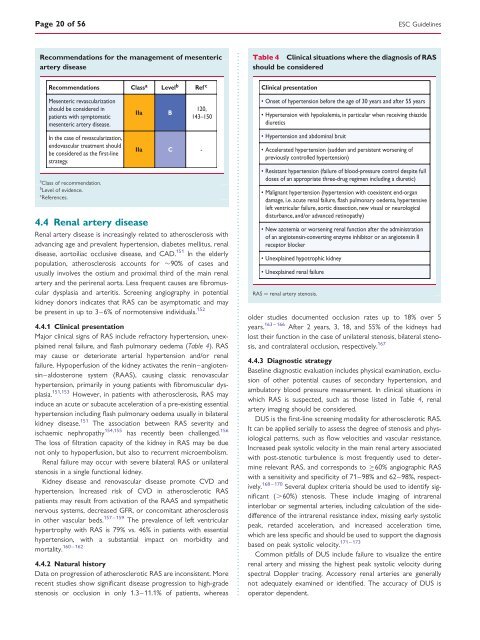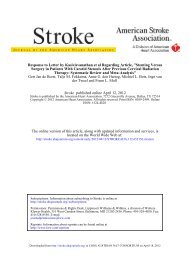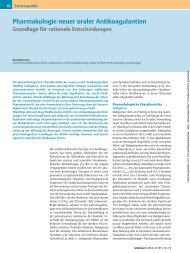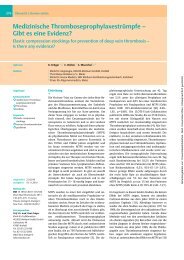ESC Guidelines on the diagnosis and treatment of peripheral artery ...
ESC Guidelines on the diagnosis and treatment of peripheral artery ...
ESC Guidelines on the diagnosis and treatment of peripheral artery ...
You also want an ePaper? Increase the reach of your titles
YUMPU automatically turns print PDFs into web optimized ePapers that Google loves.
Page 20 <strong>of</strong> 56<br />
Recommendati<strong>on</strong>s for <strong>the</strong> management <strong>of</strong> mesenteric<br />
<strong>artery</strong> disease<br />
Recommendati<strong>on</strong>s Class a Level b Ref c<br />
Mesenteric revascularizati<strong>on</strong><br />
should be c<strong>on</strong>sidered in<br />
patients with symptomatic<br />
mesenteric <strong>artery</strong> disease.<br />
In <strong>the</strong> case <strong>of</strong> revascularizati<strong>on</strong>,<br />
endovascular <strong>treatment</strong> should<br />
be c<strong>on</strong>sidered as <strong>the</strong> first-line<br />
strategy.<br />
a Class <strong>of</strong> recommendati<strong>on</strong>.<br />
b Level <strong>of</strong> evidence.<br />
c References.<br />
4.4 Renal <strong>artery</strong> disease<br />
IIa B<br />
120,<br />
143–150<br />
IIa C -<br />
Renal <strong>artery</strong> disease is increasingly related to a<strong>the</strong>rosclerosis with<br />
advancing age <strong>and</strong> prevalent hypertensi<strong>on</strong>, diabetes mellitus, renal<br />
disease, aortoiliac occlusive disease, <strong>and</strong> CAD. 151 In <strong>the</strong> elderly<br />
populati<strong>on</strong>, a<strong>the</strong>rosclerosis accounts for ≏90% <strong>of</strong> cases <strong>and</strong><br />
usually involves <strong>the</strong> ostium <strong>and</strong> proximal third <strong>of</strong> <strong>the</strong> main renal<br />
<strong>artery</strong> <strong>and</strong> <strong>the</strong> perirenal aorta. Less frequent causes are fibromuscular<br />
dysplasia <strong>and</strong> arteritis. Screening angiography in potential<br />
kidney d<strong>on</strong>ors indicates that RAS can be asymptomatic <strong>and</strong> may<br />
be present in up to 3–6% <strong>of</strong> normotensive individuals. 152<br />
4.4.1 Clinical presentati<strong>on</strong><br />
Major clinical signs <strong>of</strong> RAS include refractory hypertensi<strong>on</strong>, unexplained<br />
renal failure, <strong>and</strong> flash pulm<strong>on</strong>ary oedema (Table 4). RAS<br />
may cause or deteriorate arterial hypertensi<strong>on</strong> <strong>and</strong>/or renal<br />
failure. Hypoperfusi<strong>on</strong> <strong>of</strong> <strong>the</strong> kidney activates <strong>the</strong> renin–angiotensin–aldoster<strong>on</strong>e<br />
system (RAAS), causing classic renovascular<br />
hypertensi<strong>on</strong>, primarily in young patients with fibromuscular dysplasia.<br />
151,153 However, in patients with a<strong>the</strong>rosclerosis, RAS may<br />
induce an acute or subacute accelerati<strong>on</strong> <strong>of</strong> a pre-existing essential<br />
hypertensi<strong>on</strong> including flash pulm<strong>on</strong>ary oedema usually in bilateral<br />
kidney disease. 151 The associati<strong>on</strong> between RAS severity <strong>and</strong><br />
ischaemic nephropathy 154,155 has recently been challenged. 156<br />
The loss <strong>of</strong> filtrati<strong>on</strong> capacity <strong>of</strong> <strong>the</strong> kidney in RAS may be due<br />
not <strong>on</strong>ly to hypoperfusi<strong>on</strong>, but also to recurrent microembolism.<br />
Renal failure may occur with severe bilateral RAS or unilateral<br />
stenosis in a single functi<strong>on</strong>al kidney.<br />
Kidney disease <strong>and</strong> renovascular disease promote CVD <strong>and</strong><br />
hypertensi<strong>on</strong>. Increased risk <strong>of</strong> CVD in a<strong>the</strong>rosclerotic RAS<br />
patients may result from activati<strong>on</strong> <strong>of</strong> <strong>the</strong> RAAS <strong>and</strong> sympa<strong>the</strong>tic<br />
nervous systems, decreased GFR, or c<strong>on</strong>comitant a<strong>the</strong>rosclerosis<br />
in o<strong>the</strong>r vascular beds. 157 – 159 The prevalence <strong>of</strong> left ventricular<br />
hypertrophy with RAS is 79% vs. 46% in patients with essential<br />
hypertensi<strong>on</strong>, with a substantial impact <strong>on</strong> morbidity <strong>and</strong><br />
160 – 162<br />
mortality.<br />
4.4.2 Natural history<br />
Data <strong>on</strong> progressi<strong>on</strong> <strong>of</strong> a<strong>the</strong>rosclerotic RAS are inc<strong>on</strong>sistent. More<br />
recent studies show significant disease progressi<strong>on</strong> to high-grade<br />
stenosis or occlusi<strong>on</strong> in <strong>on</strong>ly 1.3–11.1% <strong>of</strong> patients, whereas<br />
Table 4 Clinical situati<strong>on</strong>s where <strong>the</strong> <strong>diagnosis</strong> <strong>of</strong> RAS<br />
should be c<strong>on</strong>sidered<br />
Clinical presentati<strong>on</strong><br />
• Onset <strong>of</strong> hypertensi<strong>on</strong> before <strong>the</strong> age <strong>of</strong> 30 years <strong>and</strong> after 55 years<br />
• Hypertensi<strong>on</strong> with hypokalemia, in particular when receiving thiazide<br />
diuretics<br />
• Hypertensi<strong>on</strong> <strong>and</strong> abdominal bruit<br />
• Accelerated hypertensi<strong>on</strong> (sudden <strong>and</strong> persistent worsening <strong>of</strong><br />
previously c<strong>on</strong>trolled hypertensi<strong>on</strong>)<br />
• Resistant hypertensi<strong>on</strong> (failure <strong>of</strong> blood-pressure c<strong>on</strong>trol despite full<br />
doses <strong>of</strong> an appropriate three-drug regimen including a diuretic)<br />
• Malignant hypertensi<strong>on</strong> (hypertensi<strong>on</strong> with coexistent end-organ<br />
damage, i.e. acute renal failure, flash pulm<strong>on</strong>ary oedema, hypertensive<br />
left ventricular failure, aortic dissecti<strong>on</strong>, new visual or neurological<br />
disturbance, <strong>and</strong>/or advanced retinopathy)<br />
• New azotemia or worsening renal functi<strong>on</strong> after <strong>the</strong> administrati<strong>on</strong><br />
<strong>of</strong> an angiotensin-c<strong>on</strong>verting enzyme inhibitor or an angiotensin II<br />
receptor blocker<br />
• Unexplained hypotrophic kidney<br />
• Unexplained renal failure<br />
RAS ¼ renal <strong>artery</strong> stenosis.<br />
<str<strong>on</strong>g>ESC</str<strong>on</strong>g> <str<strong>on</strong>g>Guidelines</str<strong>on</strong>g><br />
older studies documented occlusi<strong>on</strong> rates up to 18% over 5<br />
years. 163 – 166 After 2 years, 3, 18, <strong>and</strong> 55% <strong>of</strong> <strong>the</strong> kidneys had<br />
lost <strong>the</strong>ir functi<strong>on</strong> in <strong>the</strong> case <strong>of</strong> unilateral stenosis, bilateral stenosis,<br />
<strong>and</strong> c<strong>on</strong>tralateral occlusi<strong>on</strong>, respectively. 167<br />
4.4.3 Diagnostic strategy<br />
Baseline diagnostic evaluati<strong>on</strong> includes physical examinati<strong>on</strong>, exclusi<strong>on</strong><br />
<strong>of</strong> o<strong>the</strong>r potential causes <strong>of</strong> sec<strong>on</strong>dary hypertensi<strong>on</strong>, <strong>and</strong><br />
ambulatory blood pressure measurement. In clinical situati<strong>on</strong>s in<br />
which RAS is suspected, such as those listed in Table 4, renal<br />
<strong>artery</strong> imaging should be c<strong>on</strong>sidered.<br />
DUS is <strong>the</strong> first-line screening modality for a<strong>the</strong>rosclerotic RAS.<br />
It can be applied serially to assess <strong>the</strong> degree <strong>of</strong> stenosis <strong>and</strong> physiological<br />
patterns, such as flow velocities <strong>and</strong> vascular resistance.<br />
Increased peak systolic velocity in <strong>the</strong> main renal <strong>artery</strong> associated<br />
with post-stenotic turbulence is most frequently used to determine<br />
relevant RAS, <strong>and</strong> corresp<strong>on</strong>ds to ≥60% angiographic RAS<br />
with a sensitivity <strong>and</strong> specificity <strong>of</strong> 71–98% <strong>and</strong> 62–98%, respectively.<br />
168 – 170 Several duplex criteria should be used to identify significant<br />
(.60%) stenosis. These include imaging <strong>of</strong> intrarenal<br />
interlobar or segmental arteries, including calculati<strong>on</strong> <strong>of</strong> <strong>the</strong> sidedifference<br />
<strong>of</strong> <strong>the</strong> intrarenal resistance index, missing early systolic<br />
peak, retarded accelerati<strong>on</strong>, <strong>and</strong> increased accelerati<strong>on</strong> time,<br />
which are less specific <strong>and</strong> should be used to support <strong>the</strong> <strong>diagnosis</strong><br />
171 – 173<br />
based <strong>on</strong> peak systolic velocity.<br />
Comm<strong>on</strong> pitfalls <strong>of</strong> DUS include failure to visualize <strong>the</strong> entire<br />
renal <strong>artery</strong> <strong>and</strong> missing <strong>the</strong> highest peak systolic velocity during<br />
spectral Doppler tracing. Accessory renal arteries are generally<br />
not adequately examined or identified. The accuracy <strong>of</strong> DUS is<br />
operator dependent.







